#prosauropod
Explore tagged Tumblr posts
Text

composition sketch. portrait of an amurosaur recalling the triassic allegory of the three sisters
#wip#sketch#drawing#gesture#digital drawing#thumbnail#anthro art#furry art#dinosaur#saurian#hadrosaur#prosauropod#history#triassic#cretaceous#scalie#furry#anthro#dynasoar5#ssohardd#art
227 notes
·
View notes
Text
Plateosaurus deserves more love (they also deserve a better drawing. Update video incoming!) Since they're a prosauropod, I have them in my Sauropods listing :) Get them here!
#video#art#my art#paleoart#paleontology#science#illustration#dinosaur#sauropod#prosauropod#plateosaurus#triassic#early dinosaur#paleo party
17 notes
·
View notes
Text
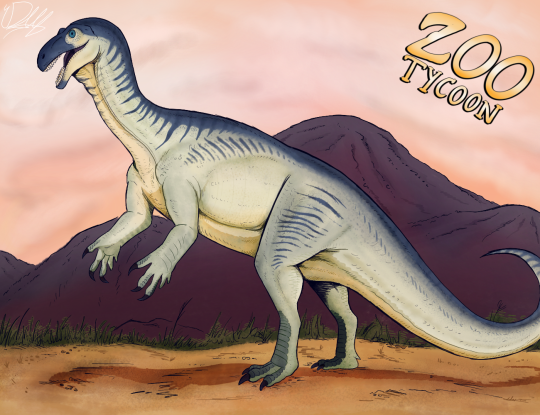
Artwork of the Plateosaurus from the Zoo Tycoon: Dinosaur Digs DLC.
It's a very primitive sauropod relative from the Triassic Period and was considered one of the largest dinosaurs of that era. Its bipedal stance contrasts the appearance of its eventual sauropod descedants.
#art#artwork#artists on tumblr#colorful#dinosaur#paleoart#paleoillustration#animal#zoo#zoo tycoon#saurischia#prosauropod#plateosaurus#sauropod#triassic#mesozoic#prehistoric#dinosaurs
85 notes
·
View notes
Note
Hellooow
Trick or treat! :D

Xingxiulong!
24 notes
·
View notes
Text

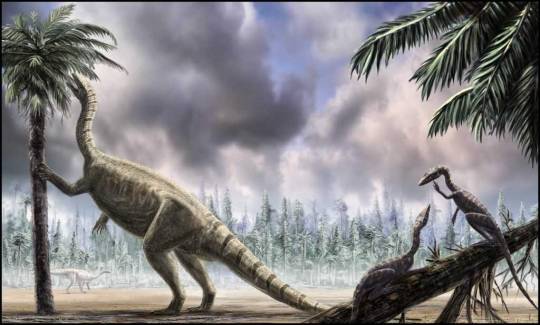
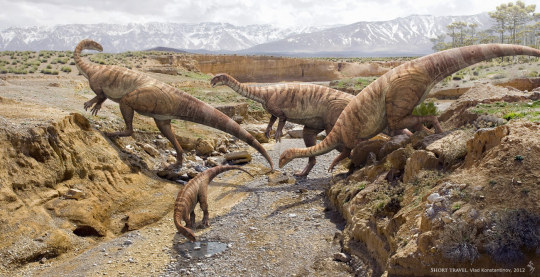
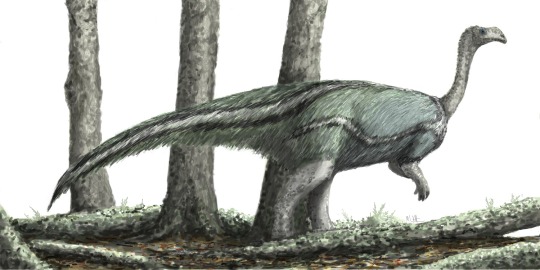
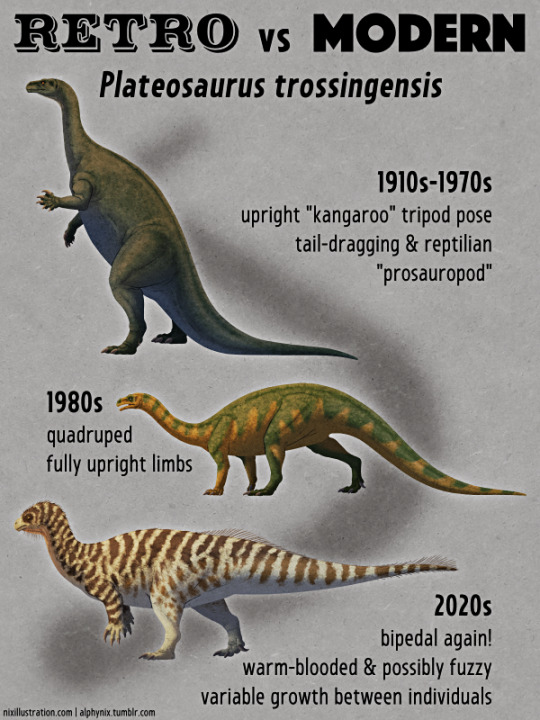
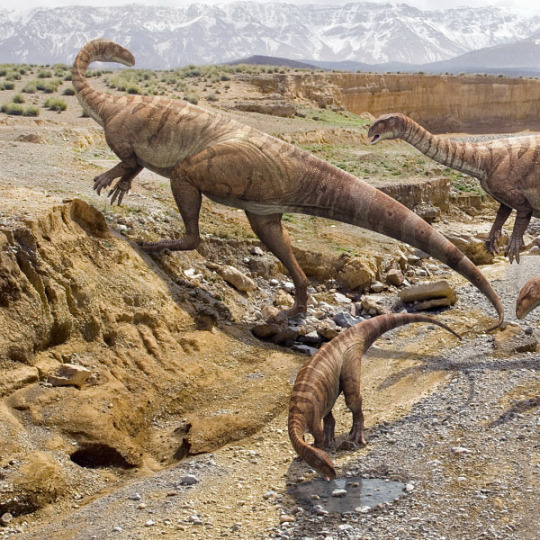
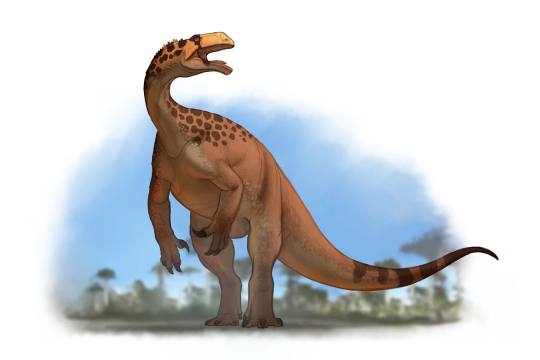
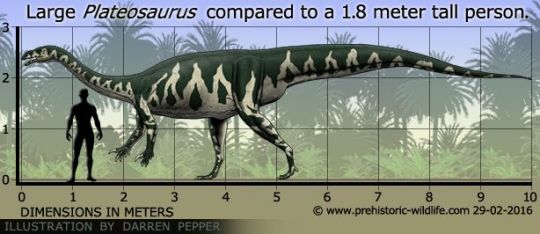


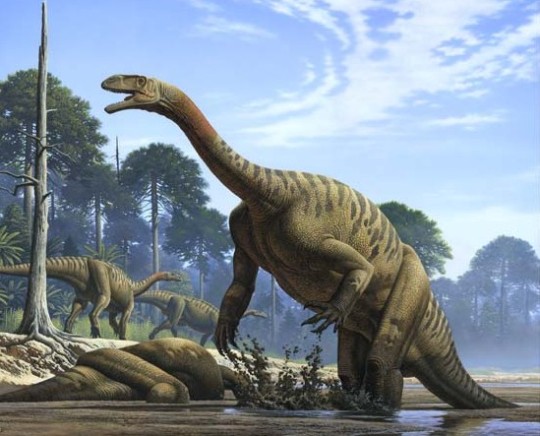
Plateosaurus is a genus of basal early sauropodomorph dinosaur aka a prosauropod, which lived throughout what is now Europe and possibly Greenland from the Norian to the Rhaetian of the late triassic some 214 to 204 million years ago. The first remains now known to belong to Plateosaurus consisted of parts of the legs and some vertebrae were unearthed in 1834 by physician Johann Friedrich Engelhardt at Heroldsberg near Nuremberg, Germany. He then showed them to palaeontologist Hermann von Meyer, who in 1837 designated them as Plateosaurus meaning broad lizard. This means that Plateosaurus is the fifth named dinosaur genus that is still considered valid. Since then the remains of well over 100 individuals have been recovered throughout Switzerland, France, Norway, and especially the German region of Swabia causing German palaeontologist Friedrich August von Quenstedt to nickname the animal Schwäbischer Lindwurm meaning the Swabian Dragon. Material referred to Plateosaurus has also been found in the Fleming Fjord Formation of East Greenland, however much of these remains have now been assigned to its own distinct genus of prosauropod called Issi. Although there remains some indeterminate material from the local still assigned to plateosaurs. Today 3 species are considered valid: P. trossingensis, P. longiceps, and P. gracilis. Unusual amongst dinosaurs, plateosaurs had a high amount in developmental plasticity with adult specimens reaching anywhere from 66 to 33ft (4.8 to 10m) in length and 1,300 to 8,800lbs (600 to 4,000kgs) in weight. Despite the great quantity and quality of fossils, Plateosaurs was for a long time a source of confusion and misunderstanding. Leading to there being considerable debate in regards animal's biology, taxonomic position, physical posture and behavior over the years. The modern understanding of these animals is that they were large obligate bipeds which sported small heads, long and flexible necks, sharp but plump plant-crushing teeth, powerful hind limbs, short but muscular arms and grasping hands with large claws on three fingers which were used for both defense and feeding. Plateosaurus likely lived in loose herds and feed upon a wide variety of vegetation, acting as the primary large herbivore of its environments, occasionally supplementing its diet with carrion, insects, or small vertebrates.
Art used above can be found at the links below
https://nixillustration.com/science-illustration/2022/retro-vs-modern-10-plateosaurus/
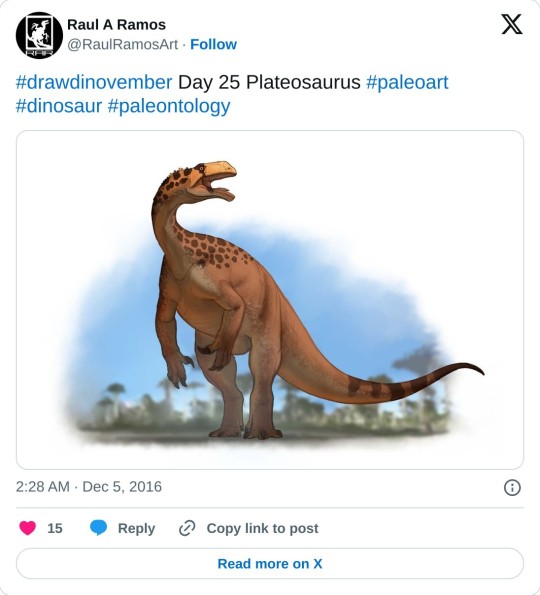
#pleistocene pride#pliestocene pride#mesozoic#dinosaur#dinosaurs#sauropod#prosauropod#sauropodomorpha#plateosaurs#dragon#triassic
7 notes
·
View notes
Text

Dinovember 2024 Day 4: Plateosaurus trossigensis
#plateosaurus#paleoart#dinosaur#dinosaurs#paleontology#palaeontology#draw dinovember#dinovember 2024#dinovember#prosauropoda#prosauropods
106 notes
·
View notes
Text
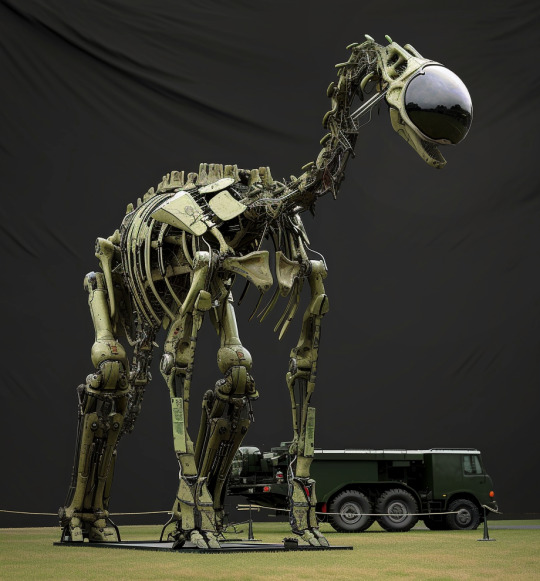
Clandestine defense expo snapshot—proof-of-concept technology demonstrator for a mid-size quadrupedal sauropodiform military cyborg chassis adapted to functional mobility in special operations on high-g worlds (presumably, those already populated by sauropodomorph dinosauriforms, sapient or otherwise).
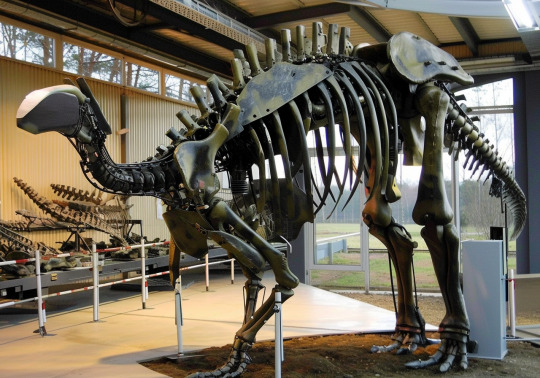
Skeleton of a prosauropodomorph combat 'borg being prepared for display at the Cybernetic War Museum. Lots of controversy about whether it's appropriate to treat the remains of cyborg veterans like this, even if the actual soldiers survived and have since been transplanted into civilian chassis.
Midjourney V6
#ai cyborgs#sauropods and prosauropods#brachiosaurus and plateosaurus#extrasolar combat#cybernetic warfare
22 notes
·
View notes
Text

A simple portrait of the skittish prosauropod anchisaurus.
#my art#illustration#dinosaur#paleontology#paleoart#paleoillustration#prehistoric#scales#anchisaurus#reptile#archosaur#desert#wildlife#wildlife art#paleo
1K notes
·
View notes
Note
just curious, why oviraptorids for your silurians?
oh I definitely tossed around a few different ideas before the oviraptors, they just ended up feeling the most right to me. here's something that could almost pass for a design process:

The first shot at a silurian I did was this tuatara redesign of the original fish guys; i didn't really like it as it doesn't feel very evocative of the original to me (the fact that they're going for "black lagoon fish man" does not jell with how subsequent designs are lizard people, and I just couldn't marry those two things well here) (also, wow, I hadn't even rewatched surface (2005) at this point, goes to show how much of a throttle that's had on my design sensibilities for the past 20 years)

I think the second was this (sort of) prosauropod, after a friend informed me that the species is canonically meant to be prosauropods (sure jan). This wasn't a super serious design, I drew it in like 5 minutes for my friends (I did consider prosauropods seriously later on, but never drew any concepts past this)

When I was looking through my folders I found this drawing next to the last, where its just the humanoid silurians but with feathers. pretty sure this was just meant to be exactly what you'd expect a feathered design would have been on the bbc in 2011. I don't remember drawing this, but here it is for posterity.

the next (actually somewhat serious) attempt made them weird raptors; at this point I was actively trying to give them a flat, owl-like face so they were evocative of the humanoid designs in the show. I really wanted them to feel like generic spec bio dinosaur people of the 2020s (a tongue in cheek update to them being generic spec bio dinosaur people for the 1970s) and this kind of has that vibe, but I didn't think it looks great; something about it feels very non expressive and kind of forced to me. (The kea-inspired colors stuck around though.)

later I revamped that sketch and added a cassowary-esque crest (you can see the one in the frilly clothes here is just that first design with a crest tacked on).
I also doodled an oviraptorid version in the corner while I had dinosaurs with crests in mind; I ended up really liking how much that looked almost human in profile, so I ended up fleshing that out more:

This looked way more expressive and bespoke to me, and felt the most evocative of the original humanoid designs (somehow), while still looking like a real dinosaur species instead of a totally made up one
so yeah the oviraptors ended up sticking around at that point - they just clicked way more than any of the other attempts!

457 notes
·
View notes
Text

DINOVEMBER 2/13: Musankwa sanyatiensis
No.2, finally. On the 7th. This is why I didn't give myself one every day folks.
This sauropodomorph was discovered near the top of Zimbabwe's Pebbly Arkose formation, dating back to around 225Ma ago. The description of the specimen, a partial leg bone, was published in May of this year by Barrett et al. It's nothing too special morphology and phylogeny wise, falling slap bang halfway between the most basal sauropodomorphs (like its compatriot Mbiresaurus) and the sauropods proper. It doesn't appear to be particularly large or small for a "prosauropod", but it's nice to have another Triassic species and an addition to the poorly studied palaeofauna of Africa. Even if the lead scientist on the paper was one of the European scientists working on the specimen and not the Zimbabwean ones. A bit yikes.
I decided to give this male some neck quills, I love a sauropodomorph neck quill, and a funky throat patch as well. I also tried to give him a dynamic pose but it didn't work out for me, so I did a more standard side shot.
#palaeostuff#anthem posts#anthems art#Musankwa#triassic#palaeontology#palaeoart#palaeoblr#paleontology#paleoart#dinovember#dinovember 2024#dinosaurs#sauropodomorpha#n class
65 notes
·
View notes
Text
Spectember 2023 #06: Some Big Reptiles
An anonymous request asked for a "large ankylosaur-like herbivorous notosuchian":
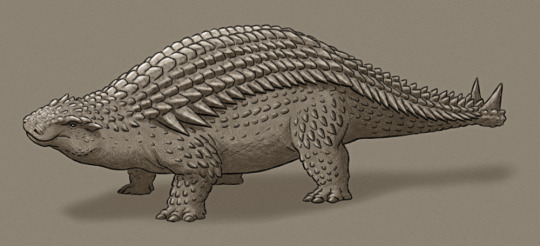
Mitafosuchus pachysomatus is descended from Simosuchus-like notosuchians in Madagascar that survived through the K-T extinction.
Highly convergent with the now-extinct ankylosaurs, it's a 5m long (~16'4") squat tank-like herbivore with hoof-like claws, and a wide short snout used for grazing on low vegetation. Heavy interlocking osteoderm amor covers most of its body, protecting it against the big carnivorous crocodyliformes that also still survive in this version of Cenozoic Madagascar.
———
Another anon wanted to see a "giant warm blooded lizard":

Atopohippus zestamenus is a descendant of invasive Argentine giant tegu lizards that became established on an island archipelago. At 2m tall (~6'6") and around 6m long (~20') it's an example of island gigantism, and occupies a high-browsing-herbivore ecological niche similar to giant tortoises and prosauropods.
Its ancestors' seasonal endothermy has become full endothermy in this species, partly due to young individuals having a very rapid growth rate and metabolism – their main defense against the predators on their island home (primarily carnivorous tegu-descendants and large birds of prey) is to simply get to a big body size as fast as they possibly can.
#spectember#spectember 2023#speculative evolution#notosuchia#crocodyliform#pseudosuchia#tegu#squamata#lizard#reptile#art#science illustration
290 notes
·
View notes
Text

drawing of a plateosaurus soldier
#drawing#sketch#digital art#digital drawing#anthro#furry#furry art#anthro art#dinosaur#saurian#triassic#plateosaurus#plateosauridae#prosauropod#fantasy art#soldier#dynasoar5#ssohardd
207 notes
·
View notes
Text










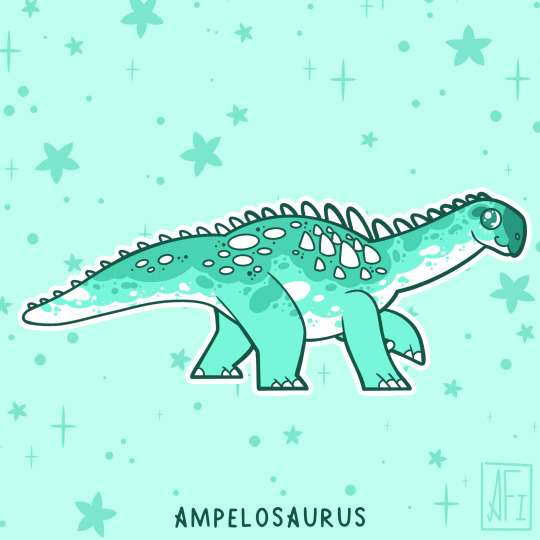





Sauropods! (and Prosauropods too)
Eoraptor is a little debated, but the current leading theory is that they're a prosauropod. Should this get updated, I'll switch them over to my theropods group lol
Stickers || Phone Wallpapers Masterlist
Planned or in the works: Antetonitrus, Ohmdenosaurus, Isanosaurus, Zby, Europasaurus, Camarasaurus, Sauroposeidon, Titanomachya, Dreadnoughtus, Saltasaurus, Rapetosaurus, Patagotitan, Nigersaurus, Mamenchisaurus, Shunosaurus
#art#my art#paleoart#paleontology#science#illustration#dinosaur#sauropods#brachiosaurus#giraffatitan#brontosaurus#plateosaurus#xinjiangitan#alamosaurus#magyarosaurus#amargasaurus#ampelosaurus#inawentu#apatosaurus#brachytrachelopan#diplodocus#eoraptor#(potentially lol)
195 notes
·
View notes
Text
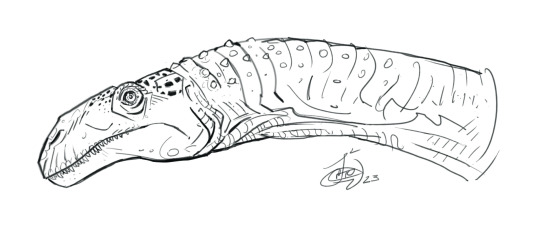
A prosauropod giving me the side-eye. Well technically they are always giving the side-eye; if you've ever spent some time around one, you'll notice that the eyeball never turns in its socket. Most critters can't; that's why you see little to no whites of the eyes in most non-mammal creatures. They have this wreath of small bones called the sclerotic ring embedded in the eye that locks them in place. Predators are usually locked pointing more to the front, prey usually locked pointing more to the side. If a creature with sclerotic rings wants to change their angle of view, they've got to rotate their neck. So yeah; that's why the perpetual side-eye expression.
Even though Prosauropods had a mixed diet of meat and plants, they always seem to me to be giving more of a side-eye than other prey critters. It's something about their expression; they always seem stressed out. And boy do they startle easily, like they're wired up on caffeine and spooky bedtime stories. Which is odd, because the first coffee shop wouldn't show up for another 210 million years.
150 notes
·
View notes
Note
triassic or treat!!!!!
Triassic you say?
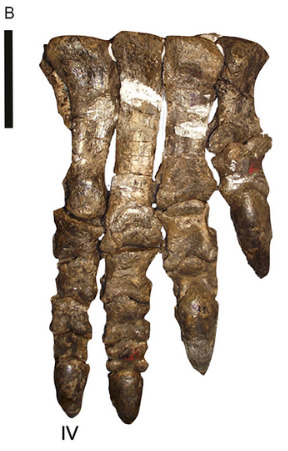
Kholumolumo!
Please do not send me more trick or treat asks, I am only answering the ones I could not get to after I hit post limit last night, it is Nov 1st we have other shenanigans to attend to!
21 notes
·
View notes
Text
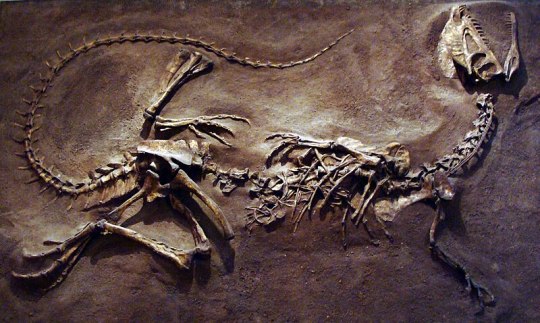
Name: Dilophosaurus wetherilli
Debut: Real Life, Circa The Early Jurassic (roughly 280 million years ago)
Hi I'm gonna talk about my favorite dinosaur now and you're gonna like it! Or maybe you won't, I don't know you! But y'know what I do know? Dilophosaurus!!! It's my best friend. They named it after the fact that it's got two (di) crests (lopho) on its head and also it's a reptile (saurus). A big reptile at that! In fact, it was the largest known animal of its time to walk the land in North America, and was almost certainly the apex predator of its environment, the Kayenta Formation (located across several of what are now the South-Western United States).

As you can see, this size chart demonstrates that the largest specimen discovered was about 7 meters (23 feet) long; no Tyrannosaurus rex, mind you, but still far larger than... some popular depictions might lead you to believe.
Also contrary to what some popular depictions might lead you to believe, Dilophosaurus would not have required the use of various biological mechanisms such as, for instance, retractable neck frills or venom-spitting to take down its prey; mechanisms which, mind you, are exclusively seen in animals as methods of self-defense, and would therefore only serve to scare away potential prey items.
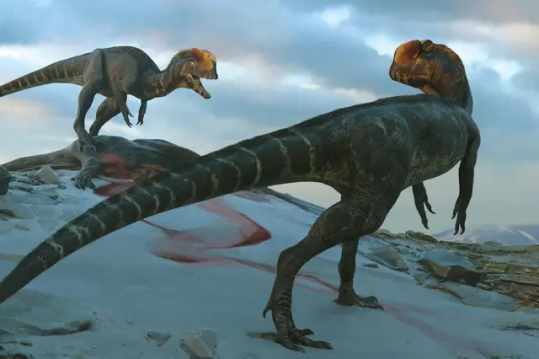
Speaking of prey items, this stunning piece by Chase Stone depicts a pair of Dilophosaurus as having just brought down a prosauropod (a name for early sauropod relatives). Dilophosaurus did in fact live alongside at least one prosauropod, Sarahsaurus, the Holotype specimen of which bears tooth marks very likely left by a certain two-crested culprit! On that note I want to address another prevalent misconception in regards to life reconstructions of this animal...
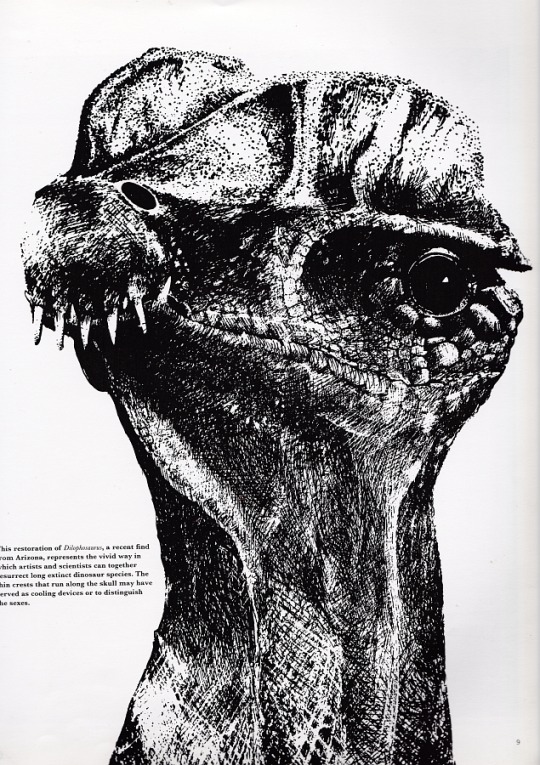
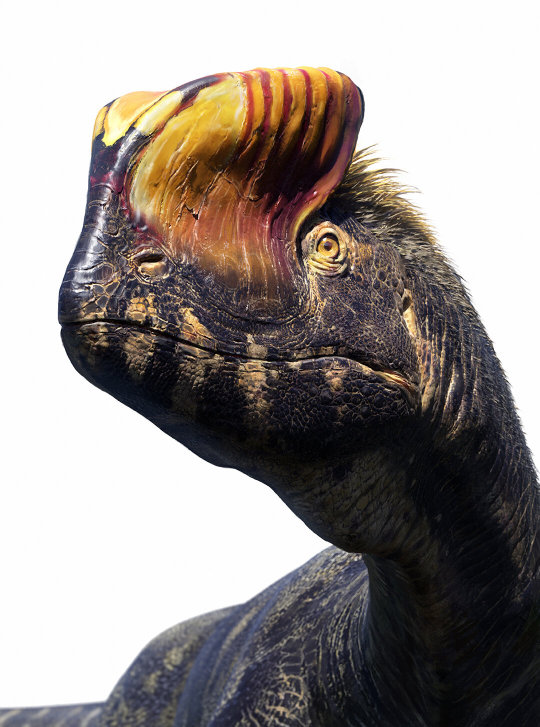
On the left we have a (frankly hilariously sock-puppet-like) restoration by a sadly unknown artist, and on the right is another absolutely breathtaking rendering by Chase Stone. As you can pretty clearly see, the way the crests (among other things) are restored is very different between the two! For a long time, the crests were restored as seen on the left: very thin, and with a little protrusion jutting out of the back. This is due to something called shrink-wrapping, a trend in paleoart exemplified by the omission of tissues such as muscle or fat when reconstructing the animal, leading to much of the skeleton being visible through the skin, particularly in the case of the skull.
Stone's restoration, on the other hand, wraps the skull in a much more naturalistic-looking amount of soft tissue, and completely envelops both crests in a keratinous structure, much like the casque of a cassowary or a hornbill (in fact I believe the coloration is actually referenced specifically from a knobbed hornbill's beak).
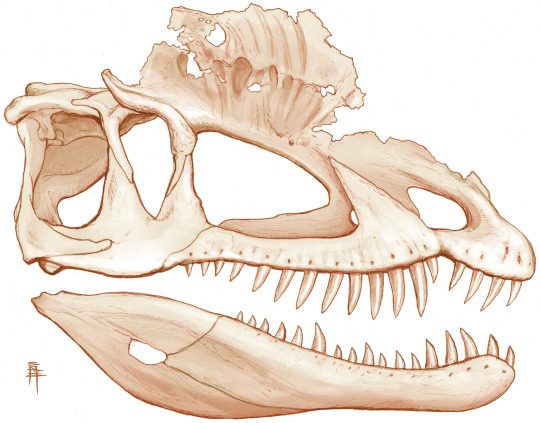
This is due to the fact that the crests were likely a kind of bony core which would have supported a larger keratinous structure as is to be expected of... sigh... horny structures such as this. Stop smiling. Don't you know there's no fun allowed when you're learning about things? That's what school taught me, anyway. Ahem. As I was saying, the original shape of the crest was extrapolated from incomplete remains, which you can see a restored illustration of above.
Also worth noting is the inclusion of a thin, fluffy covering of feathers along the head, neck, and back of Stone's restoration. This is entirely plausible, as the current consensus is that dinosaurs and their close relatives, pterosaurs, were descended from a fluffy common ancestor due to the fluffy-feathery coverings seen in both groups being found to be basically the same stuff!

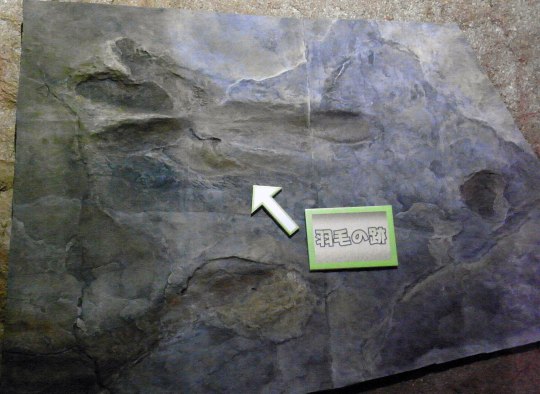
I could go on about so many things, like how tremendously fucked up and addled with tumors and infections the Holotype specimen was, or how we have a trace fossil which seems to preserve a Dilophosaurus sitting down in the mud like a big dumb bird, complete with an impression of its butt, but I trust that if these things pique your interest enough, you'll seek them out on your own time. Just remember not to have fun, because as we all know, fun is the one thing learning should never be.
64 notes
·
View notes